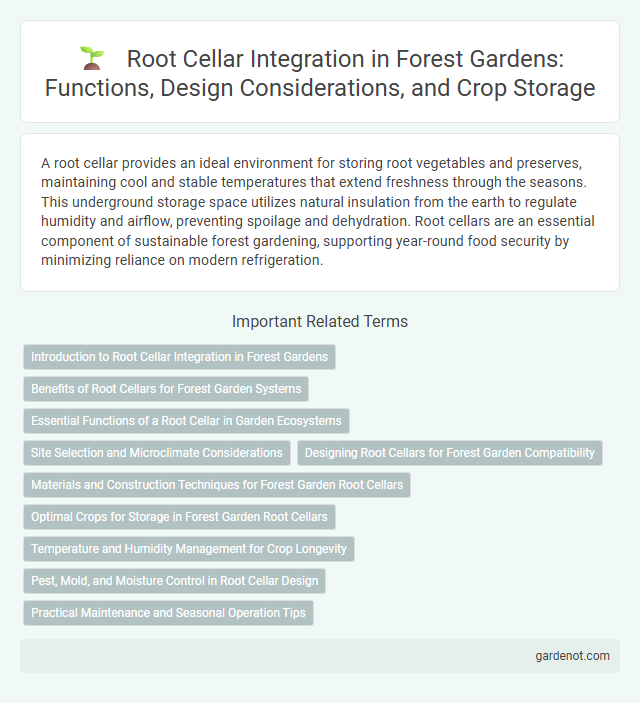A root cellar provides an ideal environment for storing root vegetables and preserves, maintaining cool and stable temperatures that extend freshness through the seasons. This underground storage space utilizes natural insulation from the earth to regulate humidity and airflow, preventing spoilage and dehydration. Root cellars are an essential component of sustainable forest gardening, supporting year-round food security by minimizing reliance on modern refrigeration.
Introduction to Root Cellar Integration in Forest Gardens
Root cellars serve as natural underground storage spaces that regulate temperature and humidity, ideal for preserving harvested produce in forest gardens. Integrating a root cellar into a forest garden design enhances sustainability by reducing spoilage and extending the availability of fruits and vegetables year-round. This method leverages earth insulation and moisture control, aligning with permaculture principles to create a resilient food system.
Benefits of Root Cellars for Forest Garden Systems
Root cellars provide a natural, energy-efficient storage solution for preserving root vegetables, fruits, and herbs harvested from forest gardens by maintaining consistent, cool, and humid conditions. These conditions slow down respiration and decay, significantly extending the shelf life of fresh produce while reducing food waste. By integrating root cellars into forest garden systems, gardeners enhance food security and sustainability through year-round access to homegrown, nutrient-rich crops.
Essential Functions of a Root Cellar in Garden Ecosystems
A root cellar maintains stable, cool, and humid conditions essential for preserving harvested root vegetables, fruits, and tubers, preventing spoilage and nutrient loss. It supports garden ecosystem sustainability by reducing food waste and enabling year-round storage of homegrown produce. This natural refrigeration method enhances biodiversity by minimizing reliance on energy-intensive refrigeration systems.
Site Selection and Microclimate Considerations
Selecting an optimal site for a root cellar involves choosing a location with stable, cool temperatures and good drainage to prevent moisture buildup and spoilage. The ideal site is typically on northern slopes or shaded areas within the forest garden to maintain consistent humidity and protect against temperature fluctuations. Microclimate factors such as soil type, airflow, and proximity to trees also influence the cellar's thermal regulation and overall preservation environment.
Designing Root Cellars for Forest Garden Compatibility
Designing root cellars for forest garden compatibility requires consideration of natural insulation from surrounding soil and integration with perennial plant systems to maintain consistent temperatures. Utilizing earth berming techniques and positioning near established tree roots enhances moisture regulation and reduces energy needs. Incorporating ventilation systems that align with local climate conditions helps preserve root vegetables while supporting the ecosystem balance in forest gardens.
Materials and Construction Techniques for Forest Garden Root Cellars
Root cellars in forest gardens are commonly constructed using natural materials like stone, earth, and untreated wood, which provide excellent insulation and moisture control necessary for storing root vegetables and preserves. Techniques such as earth berming, which involves piling soil against the walls, and using thick stone walls help maintain stable, cool temperatures year-round by leveraging the earth's natural insulation properties. Incorporating ventilated designs with adjustable openings ensures airflow regulation, preventing excess humidity and mold, which is essential for long-term food preservation in sustainable forest garden systems.
Optimal Crops for Storage in Forest Garden Root Cellars
Root cellars in forest gardens are ideal for storing hardy, nutrient-dense crops such as root vegetables like carrots, parsnips, and beets, which thrive in cool, humid conditions. Bark-mulched potatoes and winter squash varieties maintain freshness and resist rot when stored in these natural, temperature-stable environments. Apples and pears also benefit from root cellar storage, extending shelf life while preserving flavor and texture for seasonal forest garden harvests.
Temperature and Humidity Management for Crop Longevity
Maintaining optimal temperature and humidity in a root cellar is essential for prolonging the shelf life of harvested crops such as root vegetables and tubers. Ideal conditions typically range from 32degF to 40degF (0degC to 4degC) with humidity levels between 85% and 95%, preventing dehydration and decay. Effective insulation and ventilation systems regulate these conditions, ensuring a stable environment that reduces spoilage and preserves the nutritional quality of stored produce.
Pest, Mold, and Moisture Control in Root Cellar Design
Effective root cellar design incorporates pest-proofing measures such as sealed entry points and sturdy screens to prevent rodent and insect infestations. Maintaining optimal moisture levels between 85-95% relative humidity and temperatures around 32-40degF helps inhibit mold growth and preserve root vegetables. Proper ventilation systems ensure air circulation to reduce condensation and control excess moisture, enhancing the longevity and quality of stored produce.
Practical Maintenance and Seasonal Operation Tips
Root cellars require regular inspection to ensure consistent humidity levels between 85-95% and temperatures ranging from 32-40degF for optimal vegetable storage. Seasonal maintenance includes cleaning debris, monitoring ventilation to prevent mold growth, and adjusting insulation before winter to maintain stable conditions. Properly managing airflow and moisture control extends the lifespan of stored crops and preserves their nutritional quality throughout the year.
Root cellar Infographic

 gardenot.com
gardenot.com